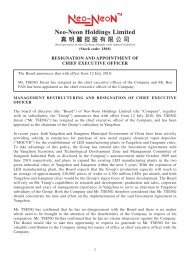Annual Report 2011 年 報 - Neo-Neon LED Lighting International Ltd
Annual Report 2011 年 報 - Neo-Neon LED Lighting International Ltd
Annual Report 2011 年 報 - Neo-Neon LED Lighting International Ltd
Create successful ePaper yourself
Turn your PDF publications into a flip-book with our unique Google optimized e-Paper software.
NotES to tHE CoNSoLIDAtED<br />
fINANCIAL StAtEMENtS<br />
4. SIGNIFICANT ACCOUNTING POLICIES (Continued)<br />
Financial instruments (Continued)<br />
Impairment of financial assets<br />
Financial assets, other than investments held-for-trading, are assessed for indicators of impairment at the<br />
end of the reporting period. Financial assets are impaired where there is objective evidence that, as a result<br />
of one or more events that occurred after the initial recognition of the financial asset, the estimated future<br />
cash flows of the financial assets have been impacted.<br />
All financial assets, objective evidence of impairment could include:<br />
• significant financial difficulty of the issuer or counterparty; or<br />
• default or delinquency in interest or principal payments; or<br />
• it becoming probable that the borrower will enter bankruptcy or financial re-organisation.<br />
For certain categories of financial asset, such as trade receivables, assets that are assessed not to be<br />
impaired individually are subsequently assessed for impairment on a collective basis. Objective evidence of<br />
impairment for a portfolio of receivables could include the Group’s past experience of collecting payments, an<br />
increase in the number of delayed payments in the portfolio past the average credit period of 60 days to 90<br />
days, observable changes in national or local economic conditions that correlate with default on receivables.<br />
For loans and receivables, an impairment loss is recognised in profit or loss when there is objective evidence<br />
that the asset is impaired, and is measured as the difference between the asset’s carrying amount and the<br />
present value of the estimated future cash flows discounted at the original effective interest rate. If, in a<br />
subsequent period, the amount of impairment loss decreases and the decrease can be related objectively<br />
to an event occurring after the impairment losses was recognised, the previously recognised impairment<br />
loss is reversed through profit or loss to the extent that the carrying amount of the asset at the date the<br />
impairment is reversed does not exceed what the amortised cost would have been had the impairment not<br />
been recognised.<br />
The carrying amount of the loans and receivables is reduced by the impairment loss directly with the<br />
exception of trade receivables, where the carrying amount is reduced through the use of an allowance<br />
account. Changes in the carrying amount of the allowance account are recognised in profit or loss. When<br />
a trade receivable is considered uncollectible, it is written off against the allowance account. Subsequent<br />
recoveries of amounts previously written off are credited to profit or loss.<br />
ANNUAL REPORT <strong>2011</strong> 61




